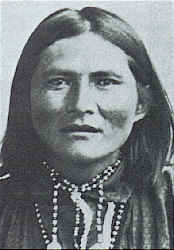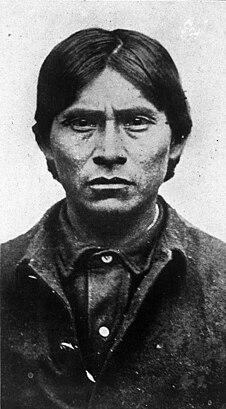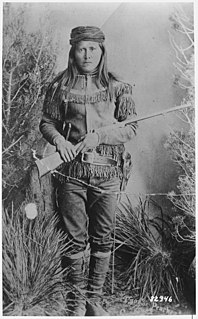 W
WNative Americans have made up an integral part of U.S. military conflicts since America's beginning. Colonists recruited Indian allies during such instances as the Pequot War from 1634–1638, the Revolutionary War, as well as in War of 1812. Native Americans also fought on both sides during the American Civil War, as well as military missions abroad including the most notable, the Codetalkers who served in World War II. The Scouts were active in the American West in the late 19th and early 20th centuries. Including those who accompanied General John J. Pershing in 1916 on his expedition to Mexico in pursuit of Pancho Villa. Indian Scouts were officially deactivated in 1947 when their last member retired from the Army at Fort Huachuca, Arizona. For many Indians it was an important form of interaction with white American culture and their first major encounter with the whites' way of thinking and doing things.
 W
WThe Alaska Territorial Guard (ATG), more commonly known as the Eskimo Scouts, was a military reserve force component of the US Army, organized in 1942 in response to attacks on United States soil in Hawaii and occupation of parts of Alaska by Japan during World War II. The ATG operated until 1947. 6,368 volunteers who served without pay were enrolled from 107 communities throughout Alaska in addition to a paid staff of 21, according to an official roster. The ATG brought together for the first time into a joint effort members of these ethnic groups: Aleut, Athabaskan, White, Inupiaq, Haida, Tlingit, Tsimshian, Yupik, and most likely others. In later years, all members of some native units scored expert sharpshooter rankings. Among the 27 or more women members were at least one whose riflery skills exceeded the men. The ages of members at enrollment ranged from 80 years old to as young as twelve. As volunteers, the Alaska Territorial Guard members were those who were too young or too old to be drafted during WWII.
 W
WAlchesay was a chief of the White Mountain Apache tribe and an Indian Scout. He received the United States military's highest decoration for bravery, the Medal of Honor, for his actions during the Indian Wars.
 W
WHaskay-bay-nay-ntayl, better known as the Apache Kid, was born in Aravaipa Canyon into one of the three local groups of the Aravaipa/Arivaipa Apache Band of San Carlos Apache, one subgroup of the Western Apache people. As a member of what the U.S. government called the "SI band", Kid developed important skills, became a famous and respected scout and later a notorious renegade active in the borderlands of the U.S. states of Arizona and New Mexico in the late 19th and possibly the early 20th centuries.
 W
WThe Apache Scouts were part of the United States Army Indian Scouts. Most of their service was during the Apache Wars, between 1849 and 1886, though the last scout retired in 1947. The Apache scouts were the eyes and ears of the United States military and sometimes the cultural translators for the various Apache bands and the Americans. Apache scouts also served in the Navajo War, the Yavapai War, the Mexican Border War and they saw stateside duty during World War II. There has been a great deal written about Apache scouts, both as part of United States Army reports from the field and more colorful accounts written after the events by non-Apaches in newspapers and books. Men such as Al Sieber and Tom Horn were sometimes the commanding officers of small groups of Apache Scouts. As was the custom in the United States military, scouts were generally enlisted with Anglo nicknames or single names. Many Apache Scouts received citations for bravery.
 W
WArikara scouts were enlisted men from the Arikara Nation serving in the U.S. Army at different frontier posts in present-day North Dakota from 1868 to 1881. The enlistment period was six months with re-enlistment possible. Each scout received a uniform, firearm and drew rations. Scout duties ranged from carrying mail between commands to tracking down traditional enemies perceived as hostile by the Army in far ranging military campaigns. Detailed to secure the horses in located enemy camps, the scouts were often the first to engage in battle. The Arikara took part when the Army protected survey crews in the Yellowstone area in the early 1870s. They participated in the Great Sioux War of 1876 and developed into Colonel George Armstrong Custer's "… most loyal and permanent scouts …".
 W
WBlanquet was an Indian Scout in the United States Army and a recipient of the U.S. military's highest decoration, the Medal of Honor, for his actions in the Indian Wars of the western United States.
 W
WBloody Knife was an American Indian who served as a scout and guide for the U.S. 7th Cavalry Regiment. He was the favorite scout of Lieutenant Colonel George Armstrong Custer and has been called "perhaps the most famous Native American scout to serve the U.S. Army."
 W
WChato was a Chiricahua Apache subchief who carried out several raids on settlers in Arizona in the 1870s. His Apache name was Bidayajislnl or Pedes-klinje. He was a protege of Cochise, and he surrendered with Cochise in 1872 going to live on the San Carlos Reservation in southern Arizona, where he became an Apache Scout. Following his service as a scout he was taken prisoner after being coerced to travel to Washington, D.C. Chato was imprisoned in St. Augustine, Florida along with almost 500 other Apache at Fort Marion.
 W
WCrow Scouts worked with the United States Army in several conflicts, the first in 1876 during the Great Sioux War. Because the Crow Nation was at that time at peace with the United States, the army was able to enlist Crow warriors to help them in their encroachment against the Native Americans with whom they were at war. In 1873, the Crow called for U.S. military actions against the Indigenous people they reported were trespassing into the newly-designated Crow reservation territories.
 W
WAshishishe, known as Curly, was a Crow scout in the United States Army during the Sioux Wars, best known for having been one of the few survivors on the United States side at the Battle of Little Bighorn. He did not fight in the battle, but watched from a distance, and was the first to report the defeat of the 7th Cavalry Regiment. Afterward a legend grew that he had been an active participant and managed to escape, leading to conflicting accounts of Curly's involvement in the historical record.
 W
WElsatsoosu, also called Elsatsoosh, was an Apache Indian scout in the U.S. Army who served under Lieutenant Colonel George Crook during the Apache Wars. He guided cavalry troopers against renegade Apaches in the Arizona Territory during Crook's winter campaign of 1872-73 and was one of ten scouts later who received the Medal of Honor for gallantry.
 W
WPompey Factor was a Black Seminole who served as a United States Army Indian Scout and received America's highest military decoration—the Medal of Honor—for his actions in the Indian Wars of the Western United States.
 W
WMickey Free, birth name Felix Telles, was an Apache Indian scout and bounty hunter on the American frontier. Following his kidnapping by Apaches as a child, he was raised as one and became a warrior. Later he joined the US Army's Apache scouts, serving at Fort Verde between December 1874 and May 1878 and was given the nickname Mickey Free.
 W
WGoes Ahead was a Crow scout for George Armstrong Custer’s 7th Cavalry during the 1876 campaign against the Sioux and Northern Cheyenne. He was a survivor of the Battle of the Little Big Horn, and his accounts of the battle are valued by modern historians.
 W
WHairy Moccasin was a Crow scout for George Armstrong Custer's 7th Cavalry during the 1876 campaign against the Sioux and Northern Cheyenne. He was a survivor of the Battle of the Little Big Horn.
 W
WHalf Yellow Face was the leader of the six Crow Scouts for George Armstrong Custer's 7th Cavalry during the 1876 campaign against the Sioux and Northern Cheyenne. Half Yellow Face led the six Crow scouts as Custer advanced up the Rosebud valley and crossed the divide to the Little Bighorn valley, and then as Custer made the fateful decision to attack the large Sioux-Cheyenne camp which precipitated the Battle of the Little Bighorn on June 25, 1876. At this time, the other Crow Scouts witnessed a conversation between Custer and Half Yellow Face. Half Yellow Face made a statement to Custer that was poetically prophetic, at least for Custer: "You and I are going home today by a road we do not know".
 W
WThomas Horn Jr. was an American scout, cowboy, soldier, range detective, and Pinkerton agent in the 19th-century and early 20th-century American Old West. Believed to have committed 17 killings as a hired gunman throughout the West, Horn was convicted in 1902 of the murder of 14-year-old Willie Nickell near Iron Mountain, Wyoming. Willie was the son of sheep rancher Kels Nickell, who had been involved in a range feud with neighbor and cattle rancher Jim Miller. On the day before his 43rd birthday, Horn was executed by hanging in Cheyenne, Wyoming.
 W
WLuther Sage "Yellowstone" Kelly was an American soldier, hunter, scout, adventurer and administrator. He served briefly in the American Civil War and then in an 1898 expedition to Alaska. He commanded a U.S. Army company in the Philippine–American War and later served in the civilian administration of the Philippines. On June 26, 1929 Yellowstone Kelly was laid to rest with full military honors overlooking the Yellowstone Valley in Billings, Montana after an impressive funeral procession.
 W
WMassai was a member of the Mimbres/Mimbreños local group of the Chihenne band of the Chiricahua Apache. He was a warrior who escaped from a train that was sending the scouts and renegades to Florida to be held with Geronimo and Chihuahua.
 W
WThe Navajo Scouts were part of the United States Army Indian Scouts between 1873 and 1895. Generally, the scouts were signed up at Fort Wingate for six month enlistments. In the period 1873 to 1885, there were usually ten to twenty-five scouts attached to units. United States Army records indicated that in the Geronimo Campaign of 1886, there were about 150 Navajo scouts, divided into three companies, who were part of the 5,000 man force General Nelson A. Miles put in the field. In 1891 they were enlisted for three years. The Navajos employed as scouts were merged into regular units of the army in 1895. At least one person served almost continuously for over twenty-five years.
 W
WPawnee Scouts were employed by the United States Army in the latter half of the 19th century. Like other groups of Indian scouts, Pawnee men were recruited in large numbers to aid in the ongoing conflicts between colonists and the Native Americans in the United States. Because the Pawnee people were at times involved in territorial skirmishes with the Sioux and Cheyenne, some of them were amenable to serving with the army for pay. A number of Pawnee served between 1865 and 1871. They were armed with rifles, revolvers and were issued scout uniforms.
 W
WJohn Rope (circa 1855/1863 – 8 August 1944, born Tlodilhil was a White Mountain Apache clan leader and Apache scout who received a medal of honor. Rope was born somewhere between Old Summit and Black River, Arizona, but says his earliest memories are from his time near Cedar Creek, which is just west of Fort Apache. Rope's father was Nayundiie, a White Mountain Apache clan leader. He was foster brother to Mickey Free.
 W
WThe "Shadow Wolves" is a unit of Native American trackers. The law enforcement unit is part of the U.S. Immigration and Customs Enforcement (ICE). The Shadow Wolves' primary task is tracking smugglers through a 76-mile (122 km) stretch of the Tohono O'odham Nation territory that runs along the Mexico–United States border in the state of Arizona.
 W
WAl Sieber was a German-American who fought in the U.S Civil War and in the American Old West against Indians. He became a prospector and later served as a Chief of Scouts during the Apache Wars.
 W
WTso-ay, also known as Panayotishn or Pe-nel-tishn, today widely known by his nickname as "Peaches", was a Chiricahua, Western Apache warrior, who also served as a scout for General George Crook during the Apache wars. Tso-ay was wounded while fighting alongside Geronimo and Chihuahua against Mexican troops, who had ambushed them after the Apache had crossed the border while being pursued by American troops.
 W
WWhite Man Runs Him was a Crow scout serving with George Armstrong Custer's 1876 expedition against the Sioux and Northern Cheyenne that culminated in the Battle of the Little Bighorn.
 W
WWhite Swan (c.1850—1904), or Mee-nah-tsee-us in the Crow language, was one of six Crow Scouts for George Armstrong Custer's 7th Cavalry Regiment during the 1876 campaign against the Sioux and Northern Cheyenne. At the Battle of the Little Bighorn in the Crow Indian Reservation, White Swan went with Major Reno's detachment, and fought alongside the soldiers at the south end of the village. Of the six Crow scouts at the Battle of the Little Bighorn, White Swan stands out because he aggressively sought combat with multiple Sioux and Cheyenne warriors, and he was the only Crow Scout to be wounded in action, suffering severe wounds to his hand/wrist and leg/foot. After being disabled by his wounds, he was taken to Reno's hill entrenchments by Half Yellow Face, the pipe-bearer (leader) of the Crow scouts, which no doubt saved his life.